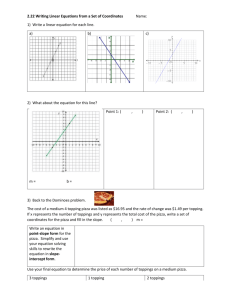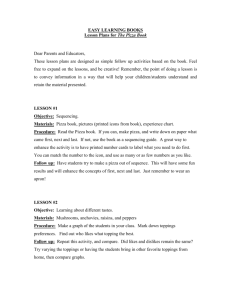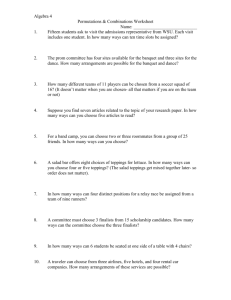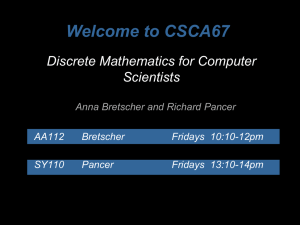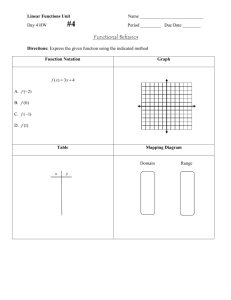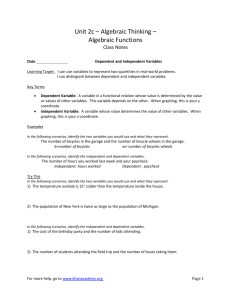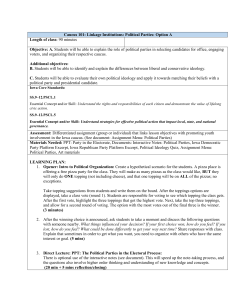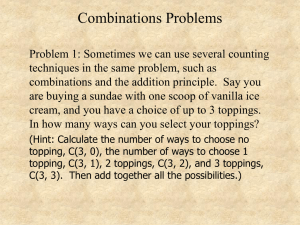MAMA SID'S PIZZA by Faith Goddard
advertisement
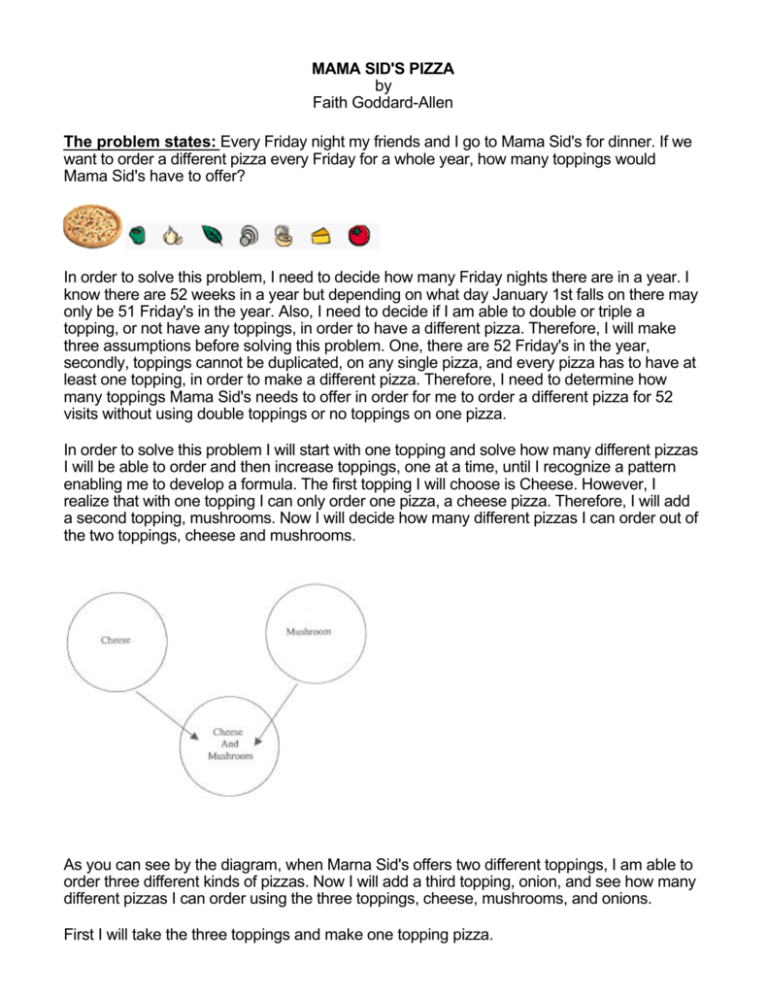
MAMA SID'S PIZZA by Faith Goddard-Allen The problem states: Every Friday night my friends and I go to Mama Sid's for dinner. If we want to order a different pizza every Friday for a whole year, how many toppings would Mama Sid's have to offer? In order to solve this problem, I need to decide how many Friday nights there are in a year. I know there are 52 weeks in a year but depending on what day January 1st falls on there may only be 51 Friday's in the year. Also, I need to decide if I am able to double or triple a topping, or not have any toppings, in order to have a different pizza. Therefore, I will make three assumptions before solving this problem. One, there are 52 Friday's in the year, secondly, toppings cannot be duplicated, on any single pizza, and every pizza has to have at least one topping, in order to make a different pizza. Therefore, I need to determine how many toppings Mama Sid's needs to offer in order for me to order a different pizza for 52 visits without using double toppings or no toppings on one pizza. In order to solve this problem I will start with one topping and solve how many different pizzas I will be able to order and then increase toppings, one at a time, until I recognize a pattern enabling me to develop a formula. The first topping I will choose is Cheese. However, I realize that with one topping I can only order one pizza, a cheese pizza. Therefore, I will add a second topping, mushrooms. Now I will decide how many different pizzas I can order out of the two toppings, cheese and mushrooms. As you can see by the diagram, when Marna Sid's offers two different toppings, I am able to order three different kinds of pizzas. Now I will add a third topping, onion, and see how many different pizzas I can order using the three toppings, cheese, mushrooms, and onions. First I will take the three toppings and make one topping pizza. Therefore, I will have three one topping pizzas when Mama Sid's offers three toppings. Now, I will see how many two topping pizzas I can make out of three toppings. When Mama Sid's offers three toppings, I can order three different kinds of two topping pizzas. Now, I realize if I order a pizza with three toppings, I will be using all the toppings on one pizza. Thus, I can only order I different pizza with three toppings. Next, in order to determine the total number of different pizzas I can order if Mama Sid's offers three toppings, I need to total the number of pizzas in each category: one, two, and three topping pizzas. Therefore, I have 3 + 3 + 1 = 7. Thus, when Mama Sid's offers three toppings, I can order 7 different kinds of pizzas. However, I need to decide how many toppings Mama Sid's needs to offer so that I can order a different kind of pizza for 52 visits so I need to continue with my solution process. Now I will see what happens when Mama Sid's offers a fourth topping, Ground Beef. I will be able to order four different kinds of one topping pizzas when Mama Sid's offers four toppings. Now I need to see how many two topping pizzas I can order from a choice of four toppings. Cheese = C, Mushrooms = M, Onions = O, Ground Beef = GB. After connecting all the two topping possibilities, I can order 6 different two topping pizzas when Mama Sid's offer four toppings. Now I will need to see how many different three topping pizzas I can order. Therefore, I will have four different three topping pizzas, when Mama Sid's offers four toppings. The last combination that I need to consider is how many pizzas will I be able to order with four toppings when four toppings are offered. However, since I will be using all the ingredients on the four topping pizzas, there will only be one possibility that I can order with four toppings. In order to determine the total number of different pizzas I can order, when Mama Sid's offers four toppings, I need to total the entire different one, two, three, and four topping pizza possibilities. Therefore, I have 4 + 6 + 4 + 1 = 15, however, 15 different pizzas is not enough for 52 visits. Thus, I have to continue on with my procedure. However, I can tell the more toppings that Mama Sid's offers the more complicated my procedure becomes for figuring out how many different kinds of pizzas I can order. Therefore, I will look at the information I have gathered this far and see if I can determine some type of pattern. In order to review my results I will make a table to represent the information I have thus far. Number of Toppings Total Number of Different Pizzas 1 1 Differences 2=2 =2 ^1 2 3 4=2*2=2^2 3 7 8=2*2*2=2^3 4 15 I can tell by looking at my table that consecutive differences are multiplies of 2. Also, I can tell by looking at my table that each consecutive multiple of 2 is raised to an additional power. For example, the first difference between one topping and two toppings is 2, which is equivalent to 2^1. The second consecutive difference between two toppings and three toppings is 2^2. Furthermore, the difference between 3 toppings and four toppings is 2^3. Therefore, I will include 2^n in the closed formula. Now I will look at the number of different pizzas I can order with each topping and determine a closed formula. When Mama Sid offers one topping I am able to order one pizza. Therefore, I am looking at 2^1 =2. However, the number of pizzas that I can order when one topping is offered is 1. Therefore, I need to alter 2^n to reflect the correct total number of different pizzas I can order. Thus, if I subtract 1 from 2^1, I get the correct answer, 1. Now I will try the formula I developed for two toppings and see if I get a correct answer. Thus, I will have 2^2 -1 = 3. Therefore, my conjecture works for one topping and two toppings. Now I will check the closed formula that I developed and see if it works for 3 toppings, so 2^3 - 1 = 7, which is the correct answer for three toppings. Also, for four toppings I have 2^4 - 1 = 15. Therefore, 2^n - 1 is the closed formula for finding the different number of pizzas I can order with (n) toppings. Now I will determine how many different pizzas I can order if Mama Sid's offers five toppings, so 2^5 1 = 31. Therefore, I know that if Mama Sid's offers five toppings I still will not be able to order 52 different pizzas. Now, I will check the closed formula, I developed, for correctness by determining how many different pizzas I can order if Mama Sid's offers five toppings. I will make tables to represent one, two, three, four, and five toppings. Let Cheese = C, Mushrooms = M, Onions = O, Sausage = S, and Ground Beef = GB One Topping: C M O S GB Two Toppings: CM CO CS CGB MO MS MGB OS OGB SGB Three Toppings: CMO CMS CMGB MOS MSGB OSGB COS MOGB CSGB COGB Four Toppings: CMOS COSGB CMSGB MOSGB CMOGB Five Toppings: Since I have five toppings, I will only be able to make one pizza out of all five toppings. I will take the totals for all the different pizzas in the set of one, two three, four, and five toppings and add them together to make sure that my closed formula works. The totals are 5 + 10 + 10 + 5 + 1 = 31 different pizzas. Also, when solving this problem utilizing my closed formula I determined that for five toppings I would be able to order 31 different pizzas. Therefore, I feel confident that the closed formula that I developed is correct. I will use the closed formula to determine how many different pizzas I can order if Mama Sid's offers 6 toppings. Thus, P(6) = 2^6 - 1 = 63 . Therefore, Mama Sid's has to offer 6 toppings if I am going to be able to order 52 different pizzas. Now that I have determined the closed formula, I need to determine the recursive formula. I can look at my table of values and look at the differences and this will help me determine the recursive formula. I will begin with two toppings. I know that when Mama Sid's offers two toppings I can order 3 different pizzas. When Mama Sid's offers onF topping I can order one pizza. I know that the recursive formula needs to begin with the previous answer, so 1 is my previous answer and P(2) = 3. I know that my differences are multiples of 2. Therefore, my recursive formula is P(n) = P(n-1) + 2^(n-1), so 3 = 1 + 2^(n-1) = 3. The recursive formula I developed is correct for P(2). Therefore, the recursive formula for the pizza problem is P(n) = P(n-1) + 2^(n-1). Pascal's Triangle Another way in which I can solve this problem is by utilizing Pascal's Triangle. I realized when I started solving this problem that I was taking a certain number of toppings and choosing different combinations of toppings, then determining how many pizzas I could order. For example, if I have three toppings and I want to determine how many different pizzas I can order by different combinations of the three toppings, I am actually saying, "I have three toppings and I want to choose one topping." In other words, out of the three toppings I am going to choose one topping and decide how many different pizzas I can order. The association with Pascal's Triangle is "3 choose 1". Therefore, starting with the highest circle on the triangle, I will go down three rows on Pascal's Triangle and over one, this number will tell me how many different combinations I can have when offered 3 toppings but choosing only 1 of the 3 toppings at a time. According to Pascal's Triangle, "3 choose 1" equals 3. I know from investigating this problem earlier that 3 is the correct answer. Now I will look at "3 choose 2". Therefore, I need to go three rows on Pascal's Triangle and over two. Pascal's Triangle As you can see from the path on the above Pascal's Triangle, when I have three toppings and I choose two, I will have 3 different combinations of two topping pizzas. Also, if I want to know how many different three topping pizzas I can order when 3 toppings are offered. Thus, I will look at "3 choose 3". I go down three rows and over three and end up with the answer 1. In order for me to get the total possible combinations of all pizzas when Mama Sid's offers three toppings, I look at "3 choose 1", "3 choose 2", and "3 choose 3,7' and add these numbers together. Therefore, I add 3 + 3 + 1 = 7. I know that this answer is right from previous investigations. Now, I will look at Pascal's Triangle and check my previous answer for the number of different pizas I can order if Mama Sid's offers 5 toppings. I will work through each step of Pascal's Triangle and then check my answer. First Step: Determine how many different 1 topping plzzas I can order from 5 toppings. Thus I am looking at "5 choose 1" which means I will go down Pascal's Triangle 5 rows and over 1. Second Step: I need to determine when offered 5 toppings how many different 2 topping pizzas I can order. Therefore, "5 choose 2" which means I will go down Pascal's Triangle 5 rows and across 2. Third Step: Determine if given five toppings how many different three topping pizzas I can order. So, "5 choose 3" which means I go down Pascal's Triangle 5 rows and across 3. Fourth Step: Determine if given 5 toppings how many different four topping pizzas I can order. So, "5 choose 4" which means I will go down Pascal's Triangle 5 rows and across 4. Fifth Step: Determine if given 5 toppings how many different 5 topping pizzas can I order. So, "5 choose 5" which means I go down Pascal's Triangle 5 rows and across 5. Last Step: Determine the total number of different pizzas I can order when Mama Sid's offers five toppings. Thus, I will add all the following: "5 choose 1," "5 choose 2," "5 choose 3," "5 choose 4," and "5 choose 5." This gives me a total of 31 different pizzas that I can order if Mama Sid's offers five toppings. Pascal's Triangle is an easy way to look at combinations. However, it is not very useful if I had to consider 10 or even 20 different toppings. In order to use Pascal's Triangle for larger combinations I would have to generate more rows, which could be very timely and I could easily make mistakes in computations. Therefore, I think that it is easier to use Pascal's Triangle to check your answers at the beginning of the problem solving process then try to develop a formula to use for solving larger combinations. In summary, 1 enjoyed working on Mama Sid's pizza problem. I think this is a good problem to assign a secondary mathematics class. I feel students would enjoy going through the steps of problems solving. In addition, I think this problem would give secondary mathematics students a chance to examine Pascal's Triangle. Also, secondary mathematics students could relate this problem to real life situations since the problem involves eating and pizza. Another element I like about Mama Sid's pizza problem is a teacher could add many extensions to the problem. For additional work with Pascal's Triangle, a teacher could give hypothetical situations where students could answer utilizing Pascal's Triangle. For example, I could ask students to find how many different pizzas I could order if a restaurant has 8 toppings and 1 want three topping pizzas. Thus, the students could look at Pascal's Triangle to solve the problem. Also, I could let the students double the toppings on each pizza, creating a different solution. Then I could increase the number of toppings to 15 and ask the students to solve the problem by using a formula. Therefore, I think that the Mama Sid's pizza problem is a good problem for secondary mathematics students to solve. Click Here to get the MS Excel Sheet for following demonstration. The Department of Mathematics Education University of Georgia ©2001
